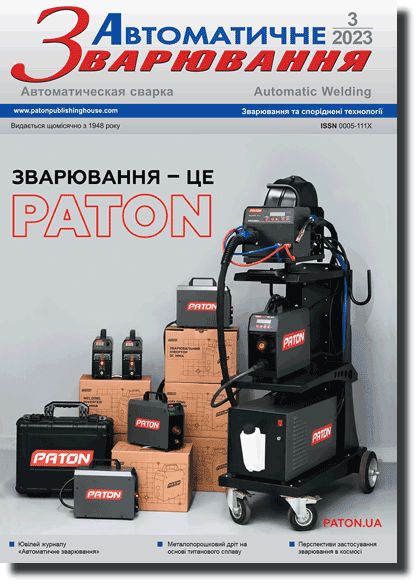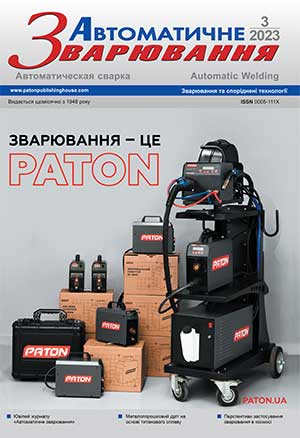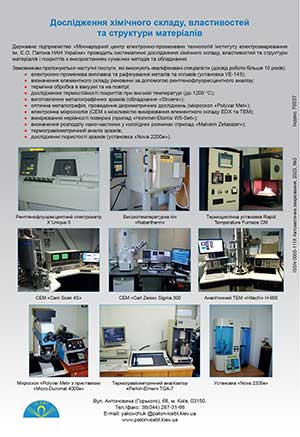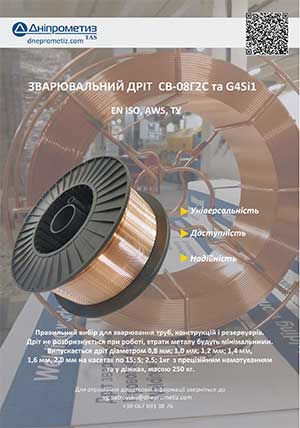| 2023 №03 (04) |
DOI of Article 10.37434/as2023.03.05 |
2023 №03 (06) |
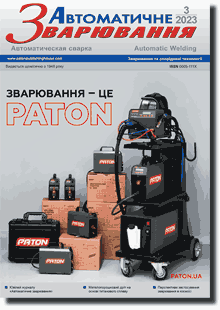
"Avtomatychne Zvaryuvannya" (Automatic Welding), #3, 2023, pp. 27-38
Mathematical modeling of residual stresses in a composite welded joint of the collector adapter sleeve to the branch pipe of ZPM-440 steam generator
A.A. Makarenko1, O.V. Makhnenko2
1STC of E.O. Paton Electric Welding Institute of the NAS of Ukraine, 11 Kazymyr Malevych Str., 03150, Kyiv, Ukraine.2E.O. Paton Electric Welding Institute of the NAS of Ukraine. 11 Kazymyr Malevych Str., 03150, Kyiv, Ukraine. E-mail: office@paton.kiev.ua
Composite welded joints of dissimilar materials, usually steel of ferrite-pearlite (bainite) and austenite classes were used in elements of equipment and pipelines of operating nuclear power plants (NPP). The considerable difference in chemical composition of base material and welding consumables leads to chemical and structural inhomogeneity of metal in the joint zone, and the difference in the coefficients of thermal expansion of the materials during welding and postweld heat treatment results in formation of high unrelaxed residual stresses, which significantly influence the strength, fatigue life and corrosion resistance of equipment elements. Considerable difficulties of experimental measurement of residual stresses make it complicated to take them into account at determination of the service life of nuclear power plant elements. Damage of the Dn-1100 welded joint in the welded assembly of the coolant collector adapter sleeve from 08Kh18N10T stainless steel and the branch pipe of the steam generator body from 22K steel is one of the problems in safe operation of WWER-440 nuclear power units. In this connection, the methods of mathematical modeling were used to perform analysis of the microstructural phase composition and residual stresses, arising in this joint in welding, and of their influence on the service life of the welded assembly. Analysis of the results of mathematical modeling of the thermal processes, microstructural phase transformations and stress-strain state (SSS) in the composite welded joint showed that hardened structures in the HAZ of branch pipe metal (St22K) and lowering of the material crack resistance characteristics can be found at violation of surfacing and welding technology during steam generator manufacture, namely non-compliance with the conditions of preheating and concurrent heating (T ≥ 200 °C). Rather high residual tensile stresses were determined on the composite joint inner surface, which is in contact with the coolant corrosive medium in operation, as well as in the zone of contact (fusion) of the material of branch pipe pearlitic steel to austenitic metal of the weld, where there is a high probability of discontinuity defect formation in welding. It may have a negative influence on the strength and structural integrity of the welded assembly of branch pipe of steam generator (SG) at further long-term service. 17 Ref., 15 Fig.
Keywords: composite welded joint, PGV-440 steam generator, heat-affected zone, microstructural phase transformations, residual stresses, mathematical modeling
Received: 08.03.2023
References
1. Makhnenko, V.I., Saprykina, G.Yu. (2002) Role of mathematical modeling in solving problems of welding dissimilar steels (Review). The Paton Welding J., 3, 14-25.2. Makhnenko, V.I., Kozlitina, S.S., Dzyubak, L.I. et al. (2010) Risk of formation of carbides and α-phase in welding of high-alloy chrome-nickel steels. The Paton Welding J., 12, 5-8.
3. Wenchun, J., Wanchuck, W., Yun, L. et al. (2017) Residual stress distribution in a dissimilar weld joint by experimental and simulation study. J. of Pressure Vessel Technology, 139, 011422-1-011422-10. https://doi.org/10.1115/1.4033532
4. Deng, D., Ogawa, K., Kiyoshima, S. et al. (2009) Prediction of residual stresses in a dissimilar metal welded pipe with considering cladding, buttering and post weld heat treatment. Computational Material Sci., 47, 398-408. https://doi.org/10.1016/j.commatsci.2009.09.001
5. Kasatkin, O.G., Tsaryuk, A.K., Skulsky, V.Yu. et al. (2007) Method for improving local damage resistance of welded joints in NPP pipelines. The Paton Welding J., 3, 27-30.
6. Khodakov, V.D., Kharina, I.D., Korneev, A.E. (2008) Examination of nature and damage causes of dissimilar welded joints in welding of transition ring to branch pipe Du1100 assembly at Novovoronezhsky and Kolsky NPP. In: Proc. of 10th Int. Conf. (St.-Petersburg, October 2008).Vol. 2, St.-Petersburg, Prometej.
7. Vardanyan, A.M. ((2017) Evaluation of influence of service conditions on residual life of assemblies of steam generators of power units WWER-440. In: Syn. of Thesis for Cand. of Tech. Sci. Degree. Erevan, NPUA [in Russian].
8. Steam generator PGV-213: Operating manual U 213-I-553 [in Russian].
9. Steam generator body: Certificate. 1137.50.06.000 PS [in Russian].
10. Steam generator body: Certificate. 1137.50.07.000 PS [in Russian].
11. Makhnenko, V.I. (2006) Safe service life of welded joints and assemblies of modern structures. Kyiv, Naukova Dumka [in Russian].
12. Kasatkin, O.G., Seyfarth, P. (2002) Calculation models for evaluation of mechanical properties of HAZ metal in welding of low-alloyed steels. In: Proc. of Int. Conf. on Mathematical Modeling and Information Technologies in Welding and Related Processes. Kyiv, 103-106.
13. (2003) Steel and alloy grades. Ed. by A.S. Zubchenko. Moscow, Mashinostroenie [in Russian].
14. Seyfarth, Meyer, Scharf (1992) Großer Atlas Schweiß- ZTU-Schaubilder Fachbuchreihe Schweißtechnik, 110. Düsseldorf, DVS Verlag.
15. (2003) Mechanical properties of structural materials in complex stress state. Ed. by A.A. Lebedev. Kyiv, In Yure [in Russian].
16. Saunders, N., Guo, U.K., Li, X. et al. (2003). Using JMatPro to model materials properties and behavior. JOM, 55, 60-65. https://doi.org/10.1007/s11837-003-0013-2
17. Margolin, B.Z., Gulenko, A.G., Kursevich, I.P. et al. (2006). Modeling for fracture in materials under long-term static creep loading and neutron irradiation. Pt 2. Prediction of creep rupture strength for austenitic materials. Strength of Materials, 38(5), 449-457. https://doi.org/10.1007/s11223-006-0064-z
Advertising in this issue:
The cost of subscription/purchase order journals or individual articles
| Journal/Currency | Annual Set | 1 issue printed |
1 issue |
one article |
| TPWJ/USD | 384 $ | 32 $ | 26 $ | 13 $ |
| TPWJ/EUR | 348 € | 29 € | 24 € | 12 € |
| TPWJ/UAH | 7200 UAH | 600 UAH | 600 UAH | 280 UAH |
| AS/UAH | 1800 UAH | 300 UAH | 300 UAH | 150 UAH |
| AS/USD | 192 $ | 32 $ | 26 $ | 13 $ |
| AS/EUR | 180 € | 30 € | 25 € | 12 € |
| SEM/UAH | 1200 UAH | 300 UAH | 300 UAH | 150 UAH |
| SEM/USD | 128 $ | 32 $ | 26 $ | 13 $ |
| SEM/EUR | 120 € | 30 € | 25 € | 12 € |
| TDNK/UAH | 1200 UAH | 300 UAH | 300 UAH | 150 UAH |
| TDNK/USD | 128 $ | 32 $ | 26 $ | 13 $ |
| TDNK/EUR | 120 € | 30 € | 25 € | 15 € |
AS = «Automatic Welding» - 6 issues per year;
TPWJ = «PATON WELDING JOURNAL» - 12 issues per year;
SEM = «Electrometallurgy Today» - 4 issues per year;
TDNK = «Technical Diagnostics and Non-Destructive Testing» - 4 issues per year.





